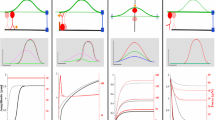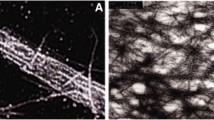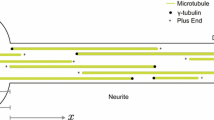Abstract
Fragments of fish melanophore cells can form and center aggregates of pigment granules by dynein-motor-driven transport along a self-organized radial array of microtubules (MTs). We present a quantitative model that describes pigment aggregation and MT-aster self-organization and the subsequent centering of both structures. The model is based on the observations that MTs are immobile and treadmill, while dynein-motor-covered granules have the ability to nucleate MTs. From assumptions based on experimental observations, we derive partial integro-differential equations describing the coupled granule–MT interaction. We use scaling arguments and perturbation theory to study the model in two limiting cases. The model analysis explains the mechanism of aster self-organization as a positive feedback loop between motor aggregation at the MT minus ends and MT nucleation by motors. Furthermore, the centering mechanism is explained by the spontaneous nucleation of MTs throughout the cytosol which acts as a volume sensing tool. Numerical simulations lend additional support to the analysis. The model sheds light on role of polymer dynamics and polymer–motor interactions in cytoskeletal organization.
Similar content being viewed by others
References
Bray, D., 2002. Cell Movements. Garland, New York.
Burakov, A., Nadezhdina, E., Slepchenko, B., Rodionov, V., 2003. Centrosome positioning in interphase cells. J. Cell Biol. 162, 963–969.
Cytrynbaum, E., Rodionov, V., Mogilner, A., 2004. Computational model of dynein-dependent self-organization of microtubule asters. J. Cell Sci. 117, 1381–1397.
Garcia, A.L., 2000. Numerical Methods for Physics. Prentice Hall, Englewood Cliffs, NJ.
Grindrod, P., 1991. Patterns and Waves. Claredon Press, Oxford, UK.
Holzbaur, E.L., Vallee, R.B., 1994. Dyneins: molecular structure and cellular function. Annu. Rev. Cell Biol. 10, 339–372.
Jager, E., Segel, L.A., 1992. On the distribution of dominance in a population of interacting anonymous organisms. SIAM J. Appl. Math. 52, 1442–1468.
Kang, K., Kololkolnikov, T., Ward, M.J., 2005. The stability and dynamics of a spike in the one-dimensional Keller-Segel model. IMA J. Appl. Math. in press.
Keller, E.F., Segel, L.A., 1970. The initiation of slime mold aggregation viewed as an instability. J. Theor. Biol. 26, 399–415.
Keller, E.F., Segel, L.A., 1971. Model for chemotaxis. J. Theor. Biol. 30, 225–234.
Kellogg, D.R., Moritz, M., Alberts, B.M., 1994. The centrosome and cellular organization. Annu. Rev. Biochem. 63, 639–674.
Lin, C.C., Segel, L.A., 1988. Mathematics Applied to Deterministic Problems in the Natural Sciences. Macmillan Publishing Co., New York.
Malikov, V., Cytrynbaum, E.N., Kashina, A., Mogilner, A., Rodionov, V., 2005. Centering of a radial microtubule array by translocation along microtubules spontaneously nucleated in the cytoplasm. Nat. Cell Biol. 7, 1213–1218.
Maly, I.V., Borisy, G.G., 2002. Self-organization of treadmilling microtubules into a polar array. Trends Cell Biol. 12, 462–465.
Nascimento, A.A., Roland, J.T., Gelfand, V.I., 2003. Pigment cells: a model for the study of organelle transport. Annu. Rev. Cell Dev. Biol. 19, 469–491.
Nedelec, F.J., Surrey, T., Maggs, A.C., Leibler, S., 1997. Self-organization of microtubules and motors. Nature 389, 305–308.
Rodionov, V.I., Borisy, G.G., 1997. Self-centering activity of cytoplasm. Nature 386, 170–173.
Rodionov, V.I., Lim, S.-S., Gelfand, V.I., Borisy, G.G., 1994. Microtubule dynamics in fish melanophores. J. Cell Biol. 126, 1455–1464.
Segel, L.A., 1972. Simplification and Scaling. SIAM Review 14, Macmillan, New York, pp. 547–571.
Schiebel, E., 2000. Gamma—tubulin complexes: Binding to the centrosome, regulation and microtubule nucleation. Curr. Opin. Cell Biol. 12, 113–118.
Tran, P.T., Marsh, L., Doye, V., Inoue, S., Chang, F., 2001. A mechanism for nuclear positioning in fission yeast based on microtubule pushing. J. Cell Biol. 153, 397–411.
Verde, F., Berrez, J.M., Antony, C., Karsenti, E., 1991. Taxol-induced microtubule asters in mitotic extracts of Xenopus eggs: Requirement for phosphorylated factors and cytoplasmic dynein. J. Cell Biol. 112, 1177–1187.
Vorobjev, I., Malikov, V., Rodionov, V., 2001. Self-organization of a radial microtubule array by dynein-dependent nucleation of microtubules. Proc. Natl. Acad. Sci. USA 98, 10160–10165.
Author information
Authors and Affiliations
Rights and permissions
About this article
Cite this article
Cytrynbaum, E.N., Rodionov, V. & Mogilner, A. Nonlocal Mechanism of Self-Organization and Centering of Microtubule Asters. Bull. Math. Biol. 68, 1053–1072 (2006). https://doi.org/10.1007/s11538-006-9092-x
Received:
Accepted:
Published:
Issue Date:
DOI: https://doi.org/10.1007/s11538-006-9092-x




